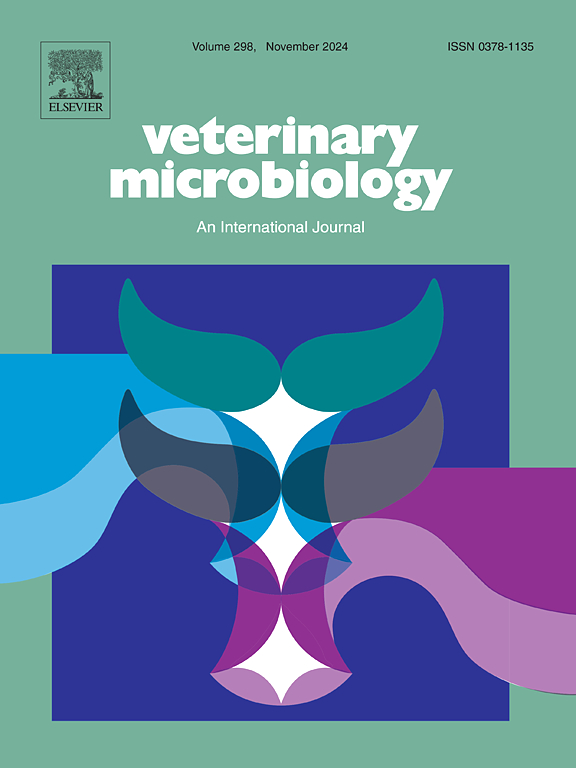Early antibody responses to lipid antigens in red deer infected with Mycobacterium bovis
IF 2.4
2区 农林科学
Q3 MICROBIOLOGY
引用次数: 0
Abstract
The problem: Early and rapid diagnosis of bovine tuberculosis remains an issue of great interest. Aim: The aim of this study was to evaluate the use of synthetic lipid antigens for diagnosis of tuberculosis in red deer (Cervus elaphus). The proposition: Synthetic mycolic acid derivatives, identical to components of mycobacterial cells, bind to antibodies to lipids produced in active human tuberculosis. Experimental infection studies in red deer (Cervus elaphus) allow the evaluation of such antigens for the serodiagnosis of bovine tuberculosis. Results: Antibody levels in plasma from deer experimentally infected with Mycobacterium bovis were evaluated in ELISA using synthetic antigens based on several classes of mycolic acid, using protein G as conjugate. All antigens gave significantly increased responses 60 days post-infection, when all animals had active disease. A significantly increased response was also observed with four antigens 15 days after infection. Conclusion: ELISA using synthetic lipid antigens not only detects antibodies in the plasma of deer experimentally infected with M. bovis, but a strong response occurs early in the infection. With a full analysis of responses with naturally infected animals, this may offer a useful supplement to current diagnostic methods.
红鹿感染牛分枝杆菌后对脂质抗原的早期抗体反应。
问题:牛结核病的早期快速诊断仍然是一个备受关注的问题。研究目的:本研究旨在评估合成脂质抗原在赤鹿(Cervus elaphus)结核病诊断中的应用。命题:合成的霉酚酸衍生物与分枝杆菌细胞的成分相同,能与活动性人类结核病产生的脂质抗体结合。通过对红鹿(Cervus elaphus)的实验感染研究,可以对这种抗原进行评估,以用于牛结核病的血清诊断:结果:使用基于几类霉菌酸的合成抗原,以蛋白 G 为共轭物,通过酶联免疫吸附试验评估了实验性感染牛分枝杆菌的鹿血浆中的抗体水平。所有抗原在感染后 60 天(当时所有动物都有活动性疾病)产生的反应都明显增加。感染后 15 天,四种抗原的反应也明显增加:结论:使用合成脂质抗原的酶联免疫吸附试验不仅能在实验性感染牛海绵状芽孢杆菌的鹿血浆中检测到抗体,而且能在感染早期产生强烈的反应。在对自然感染动物的反应进行全面分析后,这可能会成为当前诊断方法的有益补充。
本文章由计算机程序翻译,如有差异,请以英文原文为准。
求助全文
约1分钟内获得全文
求助全文
来源期刊

Veterinary microbiology
农林科学-兽医学
CiteScore
5.90
自引率
6.10%
发文量
221
审稿时长
52 days
期刊介绍:
Veterinary Microbiology is concerned with microbial (bacterial, fungal, viral) diseases of domesticated vertebrate animals (livestock, companion animals, fur-bearing animals, game, poultry, fish) that supply food, other useful products or companionship. In addition, Microbial diseases of wild animals living in captivity, or as members of the feral fauna will also be considered if the infections are of interest because of their interrelation with humans (zoonoses) and/or domestic animals. Studies of antimicrobial resistance are also included, provided that the results represent a substantial advance in knowledge. Authors are strongly encouraged to read - prior to submission - the Editorials (''Scope or cope'' and ''Scope or cope II'') published previously in the journal. The Editors reserve the right to suggest submission to another journal for those papers which they feel would be more appropriate for consideration by that journal.
Original research papers of high quality and novelty on aspects of control, host response, molecular biology, pathogenesis, prevention, and treatment of microbial diseases of animals are published. Papers dealing primarily with immunology, epidemiology, molecular biology and antiviral or microbial agents will only be considered if they demonstrate a clear impact on a disease. Papers focusing solely on diagnostic techniques (such as another PCR protocol or ELISA) will not be published - focus should be on a microorganism and not on a particular technique. Papers only reporting microbial sequences, transcriptomics data, or proteomics data will not be considered unless the results represent a substantial advance in knowledge.
Drug trial papers will be considered if they have general application or significance. Papers on the identification of microorganisms will also be considered, but detailed taxonomic studies do not fall within the scope of the journal. Case reports will not be published, unless they have general application or contain novel aspects. Papers of geographically limited interest, which repeat what had been established elsewhere will not be considered. The readership of the journal is global.
 求助内容:
求助内容: 应助结果提醒方式:
应助结果提醒方式:


